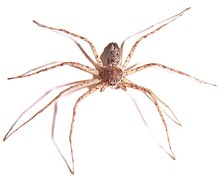Philodromidae, also known as philodromid crab spiders and running crab spiders, is a family of araneomorph spiders first described by Tord Tamerlan Teodor Thorell in 1870 (then known as subfamily Philodrominae within Thomisidae).[1] It contains over 500 species in thirty genera.[2]
| Running crab spiders Temporal range:
| |
|---|---|

| |
| Philodromus sp. | |

| |
| Running crab spider | |
| Scientific classification | |
| Domain: | Eukaryota |
| Kingdom: | Animalia |
| Phylum: | Arthropoda |
| Subphylum: | Chelicerata |
| Class: | Arachnida |
| Order: | Araneae |
| Infraorder: | Araneomorphae |
| Family: | Philodromidae Thorell, 1870 |
| Diversity | |
| 30 genera, 648 species | |

| |
The most common genus is Philodromus which is widespread, similar to Ebo.[2] Other common genera include the elongate grass-dwelling Tibellus and the widespread Thanatus, which includes the house crab spider that commonly captures flies on and in buildings.[3]
Description edit
Philodromids have a crab-like shape due to the first two pairs of legs being oriented sideways (laterigrade).[4] This is superficially similar to the "true" crab spiders (Thomisidae), such as Misumena vatia, but these families are not as closely related as previously thought.[5] Unlike crab spiders, the legs are generally similar in size, though the second leg pair may be significantly longer than the first pair.[4][5] This is most evident in Ebo, where the second pair of legs are twice as long as the first pair in some species.[5] Philodromids have scopula only at the tips of the tarsi (unlike sparassids) and the eyes are in two curved rows with the posterior row wider than the anterior row.[4] In terms of colouration, they are usually cream to light brown and have faint longitudinal stripes.[6]
Ecology edit
Philodromidae are active predators and often occur on the stems and leaves of plants.[7] Some occur only on deciduous trees and others only on conifers.[7] A small number of species live in deserts.[7] Instead of building webs to catch prey, they hunt by ambush.[6]
Genera edit
As of April 2019[update], the World Spider Catalog accepts the following genera:[2]
- Apollophanes O. Pickard-Cambridge, 1898 — North America, Asia, Trinidad, Panama, Ecuador
- Bacillocnemis Mello-Leitão, 1938 — Argentina
- Berlandiella Mello-Leitão, 1929 — Brazil, Argentina
- Cleocnemis Simon, 1886 — South America
- Ebo Keyserling, 1884 — Asia, North America, Argentina
- Eminella Özdikmen, 2007 — Argentina
- Fageia Mello-Leitão, 1929 — Brazil
- Gephyrellula Strand, 1932 — Brazil
- Gephyrina Simon, 1895 — South America, Saint Vincent and the Grenadines
- Gephyrota Strand, 1932 — Asia, Africa, Australia
- Halodromus Muster, 2009 — Spain, Asia, Africa
- Hirriusa Strand, 1932 — Namibia, South Africa
- Metacleocnemis Mello-Leitão, 1929 — Brazil
- Pagiopalus Simon, 1900 — Hawaii
- Paracleocnemis Schiapelli & Gerschman, 1942 — Argentina
- Pedinopistha Karsch, 1880 — Hawaii
- Petrichus Simon, 1886 — South America
- Philodromops Mello-Leitão, 1943 — Brazil
- Philodromus Walckenaer, 1826 — North America, Asia, Africa, Oceania, Europe, Caribbean, Central America, Venezuela
- Procleocnemis Mello-Leitão, 1929 — Brazil
- Psellonus Simon, 1897 — India
- Pseudopsellonus Balogh, 1936 — Papua New Guinea
- Pulchellodromus Wunderlich, 2012 — Algeria, Europe, Asia
- Rhysodromus Schick, 1965 — Asia, North America
- Suemus Simon, 1895 — Sierra Leone, Vietnam, South Africa
- Thanatus C. L. Koch, 1837 — Africa, Asia, North America, Europe, South America
- Tibellus Simon, 1875 — North America, Asia, Africa, South America, Cuba, Italy, Australia
- Tibitanus Simon, 1907 — Namibia, Guinea-Bissau, Guinea
- Titanebo Gertsch, 1933 — United States, Mexico
- Vacchellia Caporiacco, 1935 — Karakorum
incertae sedis edit
- Euthanatus Petrunkevitch, 1950 † (fossil)
- Filiolella Petrunkevitch, 1955 † (fossil)
- Medela Petrunkevitch, 1942 † (fossil)
See also edit
References edit
- ^ Thorell, T. (1870). "On European spiders". Nova Acta Regiae Societatis Scientiarum Upsaliensis. 3 (7): 109–242.
- ^ a b c "Family: Philodromidae Thorell, 1870". World Spider Catalog. Natural History Museum Bern. Retrieved 2019-04-23.
- ^ Kulczyński, W. (1903). "Aranearum et Opilionum species in insula Creta a comite Dre Carolo Attems collectae". Bulletin International de l'Académie des Sciences de Cracovie. 1903: 50.
- ^ a b c "araneae - Key to families". araneae.nmbe.ch. Retrieved 2022-07-12.
- ^ a b c Homann, H. (1975). "Die Stellung der Thomisidae und der Philodromidae im System der Araneae (Chelicerata, Arachnida)". Zeitschrift für Morphologie der Tiere. 80 (3): 181–202. doi:10.1007/BF00285652. S2CID 2027596.
- ^ a b "PHILODROMIDAE Philodromids". www.arachne.org.au. Retrieved 2022-07-12.
- ^ a b c "Philodromid Crab Spiders - Encyclopedia of Life". eol.org. Retrieved 2022-07-12.